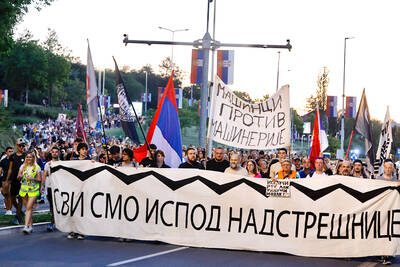Afghanistan has many dubious distinctions on the international-rankings front: 10th poorest, third most corrupt, worst place to be a child, longest at war. To that may soon be added: most heavily fingerprinted.
Since September, Afghanistan has been the only country in the world to fingerprint and photograph all travelers who pass through Kabul International Airport, arriving and departing.
A handful of other countries fingerprint arriving foreigners, but no country has ever sought to gather biometric data on everyone who comes and goes, whatever their nationality. Nor do Afghan authorities plan to stop there: Their goal is to fingerprint, photograph and scan the irises of every living Afghan.
It is a goal heartily endorsed by the US military, which has already gathered biometric data on 2 million Afghans who have been encountered by soldiers on the battlefield, or who have just applied for a job with the coalition military or its civilian contractors.
The Kabul airport program is also financed by the US, with money and training provided by the US embassy. US citizens, like all other travelers, are subject to it.
“Some of the embassies are quite exercised about it,” one Western diplomat said.
Such a program would be illegal if carried out in the home countries of most of the occupying coalition. The US and Japan fingerprint all foreigners on arrival; South Korea plans to start doing so in January. Brazil retaliated against the US program by fingerprinting arriving US citizens only. Officials at the US embassy declined to comment specifically on the program; a spokesman for the US Department of Homeland Security denied it had anything to do with it.
Biometric data is also being gathered by the US military at all of Afghanistan’s eight major border crossings, in a program that it plans to hand over to the Afghan government at the end of this month. So far, that program gathers only random samples at border crossings because traffic is so heavy, but since it began in April it has already added 200,000 people to the military’s biometrics database.
The military wants to use biometrics to identify known or suspected insurgents and to prevent infiltration of military bases and Afghan security forces.
Gathering the data does not stop at Afghanistan’s borders, however, since the military shares all of the biometrics it collects with the US Department of Justice and Homeland Security through interconnected databases.
Even the civilian-run airport program collecting fingerprints and photographs feeds its information into computers at the US embassy, as well as at the Afghan Ministry of the Interior and its intelligence agency, the National Directorate of Security, according to head of the Kabul International Airport, Mohammad Yaqub Rasuli.
Rasuli acknowledges that the airport screening has had a rocky start.
“We are happy with the system, but the airlines and the passengers are not that happy,” he said.
Delays of up to two hours have resulted from the screening, which takes at least three minutes per passenger. With six screening stations at most, the process becomes laborious and so many travelers recently have been missing their flights that the airlines routinely delay takeoffs.
Reporters at the airport have on several occasions witnessed immigration officers just waving through some passengers as crowds backed up; others were allowed to skip their thumbprints to speed things along. One man had his hand fingerprinted upside down, with nails facing the scanner.
“It is some sort of cultural deficiency,” Rasuli said. “After six months, everyone will be happy with it.”
The next step will be a national identity card with biometric data on every citizen, he said.
Information on each person is fed into a computer to find those who are on terrorist watch lists, have outstanding criminal warrants or are businessmen under investigation.
How many suspects have been apprehended with the new system, Rasuli was asked.
“None,” he said.
The military has done somewhat better with its program, according to director of the US Army’s biometrics task force, Colonel Fred Washington. Since 2007, when biometric collection began in Afghanistan, biometrics have been used to identify 3,000 suspects on either Watch List 1 or Watch List 2, the US military’s two most serious classifications for possible insurgents or terrorists. In many cases, fingerprints found on bomb remains have identified the bomb-maker, he said.
“People are accepting it because they know it’s making their country secure,” Washington said.
Executive director of the Afghan Independent Human Rights Commission, Mohammad Musa Mahmoodi, said: “Given the circumstances in Afghanistan, fighting terrorism and insurgency, government can take measures to protect its citizens.”
Civil liberties groups abroad are more concerned.
“The situation in Afghanistan is unprecedented, but I worry that we could move into that situation in the United States without even realizing we’re doing it,” said Jennifer Lynch, a staff attorney at the Electronic Frontier Foundation in San Francisco.
There have been some signs of Afghan sensitivities as well. A program to gather biometric data Kandahar last year, during the push to control insurgency there, was so unpopular that Afghan President Hamid Karzai promised local elders to have it canceled, which it was, according to Zalmai Ayoubi, a spokesman for the governor in Kandahar Province.
The Afghan government has yet to pass legislation providing for the biometric screening of the entire population that it plans to carry out for the national identity card.
As a result, the military has not conducted wholesale sweeps of communities to gather biometrics, Washington said, although in just the past year 12,000 soldiers have been trained to use the Biometric Automated Toolset (BAT).
“We can’t go door to door,” he said.
The Commander’s Guide to Biometrics in Afghanistan, however, encourages documenting as many Afghans as possible.
“Every person who lives within an operational area should be identified and fully biometrically enrolled with facial photos, iris scans and all 10 fingerprints [if present],” the guide says.
While the BAT equipment is portable, it is not always easy to use and the results can sometimes be unpredictable.
A reporter from the New York Times, a US citizen of Norwegian rather than Afghan extraction, voluntarily submitted to a test screening with the BAT system. After his fingerprints and iris scans were entered into the BAT’s armored laptop, an unexpected “hit” popped up on the screen, along with the photograph of a heavily bearded Afghan.
The “hit” identified the reporter as “Haji Daro Shar Mohammed,” who is on terrorist Watch List 4, with this note: “Deny access, do not hire, subject poses a threat.”

In the sweltering streets of Jakarta, buskers carry towering, hollow puppets and pass around a bucket for donations. Now, they fear becoming outlaws. City authorities said they would crack down on use of the sacred ondel-ondel puppets, which can stand as tall as a truck, and they are drafting legislation to remove what they view as a street nuisance. Performances featuring the puppets — originally used by Jakarta’s Betawi people to ward off evil spirits — would be allowed only at set events. The ban could leave many ondel-ondel buskers in Jakarta jobless. “I am confused and anxious. I fear getting raided or even

Kemal Ozdemir looked up at the bare peaks of Mount Cilo in Turkey’s Kurdish majority southeast. “There were glaciers 10 years ago,” he recalled under a cloudless sky. A mountain guide for 15 years, Ozdemir then turned toward the torrent carrying dozens of blocks of ice below a slope covered with grass and rocks — a sign of glacier loss being exacerbated by global warming. “You can see that there are quite a few pieces of glacier in the water right now ... the reason why the waterfalls flow lushly actually shows us how fast the ice is melting,” he said.

Eleven people, including a former minister, were arrested in Serbia on Friday over a train station disaster in which 16 people died. The concrete canopy of the newly renovated station in the northern city of Novi Sad collapsed on Nov. 1, 2024 in a disaster widely blamed on corruption and poor oversight. It sparked a wave of student-led protests and led to the resignation of then-Serbian prime minister Milos Vucevic and the fall of his government. The public prosecutor’s office in Novi Sad opened an investigation into the accident and deaths. In February, the public prosecutor’s office for organized crime opened another probe into

RISING RACISM: A Japanese group called on China to assure safety in the country, while the Chinese embassy in Tokyo urged action against a ‘surge in xenophobia’ A Japanese woman living in China was attacked and injured by a man in a subway station in Suzhou, China, Japanese media said, hours after two Chinese men were seriously injured in violence in Tokyo. The attacks on Thursday raised concern about xenophobic sentiment in China and Japan that have been blamed for assaults in both countries. It was the third attack involving Japanese living in China since last year. In the two previous cases in China, Chinese authorities have insisted they were isolated incidents. Japanese broadcaster NHK did not identify the woman injured in Suzhou by name, but, citing the Japanese